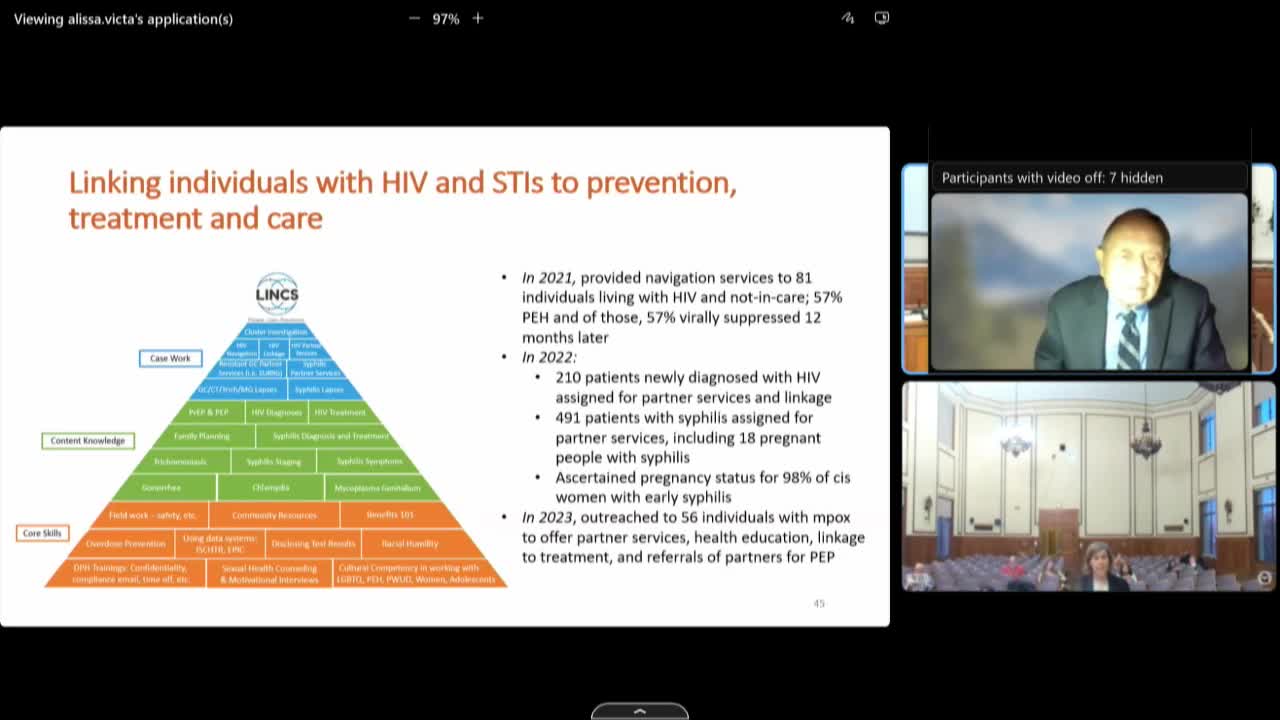Local task force makes strides in preventing congenital syphilis among pregnant individuals
December 05, 2023 | San Francisco City, San Francisco County, California

This article was created by AI summarizing key points discussed. AI makes mistakes, so for full details and context, please refer to the video of the full meeting. Please report any errors so we can fix them. Report an error »

The recent government meeting highlighted significant strides in public health initiatives aimed at addressing HIV and syphilis in San Francisco. A key focus was the navigation services provided to individuals living with HIV, with 81 people receiving support in 2021. Notably, nearly 60 percent of these individuals were experiencing homelessness, and 57 percent achieved viral suppression, marking a positive trend in health outcomes for this vulnerable population.
The meeting also addressed the urgent issue of congenital syphilis, which has become a national and local concern. In response, the Biden administration has established a federal task force dedicated to tackling syphilis and congenital syphilis. Locally, San Francisco has been proactive with its own citywide congenital syphilis prevention task force, which has been operational for several years. This collaborative effort, involving various health partners, successfully averted approximately 50 percent of potential congenital syphilis cases in 2022.
The task force is implementing several initiatives, including case review boards to identify missed opportunities for intervention, enhancing syphilis screening processes, and improving electronic health record systems. Additionally, there is a strong emphasis on increasing provider knowledge regarding syphilis screening, particularly during pregnancy. New recommendations now advocate for syphilis screening three times during pregnancy, including at delivery, which officials believe has positively impacted health outcomes.
Despite these efforts, challenges remain, particularly with pregnant individuals diagnosed with syphilis at delivery, often due to a lack of prenatal care. The meeting underscored the importance of continued education and outreach to ensure that all expectant mothers receive the necessary health services.
As San Francisco continues to address these pressing health issues, the collaborative efforts of local health organizations and the city government aim to improve the overall health and well-being of its residents, particularly those most at risk.
The meeting also addressed the urgent issue of congenital syphilis, which has become a national and local concern. In response, the Biden administration has established a federal task force dedicated to tackling syphilis and congenital syphilis. Locally, San Francisco has been proactive with its own citywide congenital syphilis prevention task force, which has been operational for several years. This collaborative effort, involving various health partners, successfully averted approximately 50 percent of potential congenital syphilis cases in 2022.
The task force is implementing several initiatives, including case review boards to identify missed opportunities for intervention, enhancing syphilis screening processes, and improving electronic health record systems. Additionally, there is a strong emphasis on increasing provider knowledge regarding syphilis screening, particularly during pregnancy. New recommendations now advocate for syphilis screening three times during pregnancy, including at delivery, which officials believe has positively impacted health outcomes.
Despite these efforts, challenges remain, particularly with pregnant individuals diagnosed with syphilis at delivery, often due to a lack of prenatal care. The meeting underscored the importance of continued education and outreach to ensure that all expectant mothers receive the necessary health services.
As San Francisco continues to address these pressing health issues, the collaborative efforts of local health organizations and the city government aim to improve the overall health and well-being of its residents, particularly those most at risk.
View full meeting
This article is based on a recent meeting—watch the full video and explore the complete transcript for deeper insights into the discussion.
View full meeting
